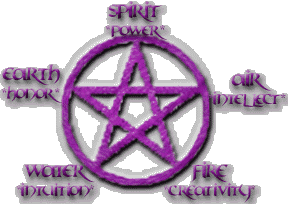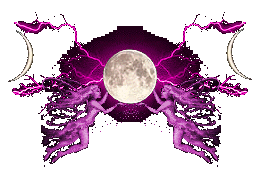
UNIVERSALITY
OF WITCHCRAFT AND PAGANISM
By
Blue
From the time man walked on earth, worship
of life sustaining elements - air, water, wind, rains, plants,
earth, fire, sun, and others - has been the first religion. And
man must have prayed to them with great awe for sustenance, blessings
and protection, for himself and his own. Thus paganism and witchcraft
came into existence.
Witchcraft is
using of natural powers, herbs, prayers and chants in healing
and seeking help of universal powers. Paganism is worship of nature
and forces of nature as forms of godhood, and also worship of
the universal energy as God and Goddess.
The birth of formal
religions took place much later. Most religions have a great deal
of paganism and witchcraft included in them.
Followers of all
religions celebrate rites as per the moon cycles, the changing
of seasons, the harvest festivals, and prayers for protection
of self, family, wealth, community, worship of God with one name
or several forms and names. Usage of herbs and chants are common
to most households.
Then why are paganism
and witchcraft besmirched, banned and feared so much by certain
religions? And why are there misconceptions in the minds of people
about stinky fumes, warts, cats and bats, pointed droopy hats,
dark robes and shrieks in the nights?
History tells
us that when the priests and leaders of certain religions felt
their control and power over common folks slip away due to the
goodness, healing and prayers of wise medicine men and women,
they ostracized them. They did not want the common folks to depend
on anyone but them. The healers hid in deep forests to save their
lives, and visited the villages at midnight with faces hidden
and in dark garbs to heal the sick or procure staples.
Those who took
help and those who helped such healers were also punished. In
order to ensure their control was complete, the religious leaders
ordered the torture and hanging or burning of tens of thousands
of such healers/witches. The healers used certain code words for
the life saving herbs and plants such as toad's toe and bat's
wings to prevent the misuse of their valuable knowledge by those
in power!! Later on, laws were passed in some countries banning
witch hunting and killing, but a great deal of knowledge and wisdom
was already wiped out by that time.
The Hindu religion
- Sanathana Dharma (The Universal Religion) - has as its integral
part, witchcraft and paganism as they are understood today. The
oldest of written books available today, the Rig Veda, gives beauteous
description of nature and worship of nature in its various forms.
All elements of nature are worshipped as Gods and Goddesses. The
Vayu Devata (wind god), Varuna Devata (rain god), the Bhu Mata
(mother earth), the Surya Devata (the sun god), Go Mata ( the
mother cow), Agni Devata (fire god) are deities who are worshipped
in the every Hindu household.
The Hindu religion
is vast and encompasses various schools of thoughts, with as many
schools for as many of the stages of development of the aspirants!!
There are some who worship Godhood in form of The Spirit and others
who worship the functions of Godhood in multitude of forms. Hinduism
does not teach blind faith but teaches testing of every truth
by checking it - neti, neti, neti, … not this, not this,
not this,… this is not the truth and ultimately what is left
is the truth!
The Sama Veda
contains ragas or tunes, songs in praise of Nature and Godhood.
The songs and tunes are very scientific and are used in sound
therapy. Each raga produces specific results like causing rains,
healing of sick, increasing valor, giving peace of mind etc. The
Atharva Veda contains spells and chants, for both black and white
purposes with specific warnings of consequences in misusing of
the spells. Use of mantra or chants for mundane goals is normal
in all Hindu households.
The harvest festivals
which offer thanksgiving to Mother Nature and Mother Earth for
their bounties, the festivals marking changing of direction of
sun, the equinoxes, the eclipses, the seasons, festivals for various
god and goddesses are celebrated all over India with great gusto
and fervor. Respect for nature and nature protection and conservation
is a part of the Hindu philosophy.
During worship,
the marking of scared space by mantras (spells and chants) and
little drawings or symbols called rangolis are done. Sprinkling
of holy water, clearing the space with burning of incense and
camphor, the invoking of directions, gods, planets for specific
purposes by chants, lighting of lamps add great power to worship.
All worship is done by the lunar calendar.
Worship is offered
in homes, temples and in open spaces too to honor nature and earth.
Offering of consecrated food to insects, birds, animals before
eating food oneself is a daily Hindu thanksgiving ritual. The
rule of chanting and asking by threes holds here.
Every village
has its own group of medicine men and women who are traditional
healers. Their powers, wisdom and training are passed on from
generation to generation. They heal by touch, mantra or spells,
and herbs. Some are truly gifted. They can heal scorpion stings
and poisonous snake bites by mere touch! They are respected and
venerated by the common man. Most temple priests heal by chants
and sprinkling of consecrated water on the sick person.
The use of herbs
and plants in healing is well known to all Hindus. The usage of
herbs such as turmeric for antiseptic purposes, for healing of
stomach ulcer, as epilator, for face packs and skin softeners;
the fenugreek seeds for healing of period pains, stomach ulcers,
increasing stamina and resistance power, as hair softener, as
skin softener and dandruff remover are common. Varieties of such
herbs are found in the home of the Hindu who usually runs to the
kitchen for medication rather than go to doctor or pharmacists
for small ailments.
Healing by energy,
the pranic system is extremely well developed in India. The knowledge
and application of Chakra systems and aura in healing is used
by pranic healers. Meditation, pranayama or breathing patterns,
body postures are a part of average Hindu life.
The average witch
or pagan of the yore would be deeply respected and accepted by
the Hindus of past and today as a brother/sister!!
I speak in detail
about the Hindu way of life, for in this birth, this soul wears
the robes of a Hindu. While a rose by another name, still smells
the same; a chrysanthemum by any other name is easier to spell.
And any pagan or witch will understand what I mean

|